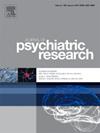全国代表性PTSD个体样本中最坏事件创伤的人口学和临床关联
IF 3.7
2区 医学
Q1 PSYCHIATRY
引用次数: 0
摘要
创伤后应激障碍(PTSD)是一种高度异质性的疾病,大约有636,120种不同的症状组合。本研究的目的是在一个具有全国代表性的美国成年终身PTSD患者(N = 2339)中,研究最严重事件创伤与人口学特征、精神合并症和PTSD症状的关系。该研究使用来自全国酒精及相关疾病流行病学调查iii的数据,使用调查加权逻辑分析和线性回归分析来检查最严重事件创伤的相关性。童年的性侵犯与女性性(AOR = 3.46, 95% CI 2.34 - -5.11),被少数性(优势比= 2.03,95% CI 1.24 - -3.31),年轻的年龄(β=−0.23 SE = 0.05),收入较低(β=−0.27 SE = 0.07),社会焦虑障碍共病(优势比= 1.57,95% CI 1.09 - -2.26),恐慌症(优势比= 1.70,95% CI 1.23 - -2.35),广场恐怖症(优势比= 1.86,95% CI 1.22 - -2.83),边缘型人格障碍(优势比= 1.49,95% CI 1.12 - -1.97),和更大的创伤后应激障碍严重程度(β= 0.55,= 0.07。成人性侵犯与单身(AOR = 0.48, 95% CI 0.28-0.80)和较大的创伤后应激障碍症状(β = 0.10, SE = 0.02)相关。身体损伤与男性(AOR = 0.61, 95% CI 0.44-0.84)和较低的抑郁几率相关(AOR = 0.54, 95% CI 0.37-0.77)。目前的研究结果表明,需要对创伤后应激障碍的标准进行更多的检查,以及创伤指数如何影响诸如合并症和症状等因素。研究结果还表明,需要进行纵向研究,以更好地分析PTSD诊断中存在的异质性。本文章由计算机程序翻译,如有差异,请以英文原文为准。
Demographic and clinical associations of worst event trauma among a nationally representative sample of individuals with PTSD
Posttraumatic stress disorder (PTSD) is a highly heterogenous disorders with approximately 636,120 different symptom combinations. The goal of the present study was to examine the association of worst-event trauma with demographic characteristics, psychiatric comorbidities, and PTSD symptoms among a large nationally representative sample of US adults with lifetime PTSD (N = 2339). The study used data from the National Epidemiologic Survey on Alcohol and Related Conditions-III to examine correlates of worst-event trauma using survey-weighted logistic and linear regression analyses. Childhood sexual assault was associated with female sex (AOR = 3.46, 95 % CI 2.34–5.11), being a sexual minority (AOR = 2.03, 95 % CI 1.24–3.31), younger age (β = −0.23, SE = 0.05), lower income (β = −0.27, SE = 0.07), comorbid social anxiety disorder (AOR = 1.57, 95 % CI 1.09–2.26), panic disorder (AOR = 1.70, 95 % CI 1.23–2.35), agoraphobia (AOR = 1.86, 95 % CI 1.22–2.83), borderline personality disorder (AOR = 1.49, 95 % CI 1.12–1.97), and greater PTSD severity (β = 0.55, SE = 0.07. Adult sexual assault was associated with being single (AOR = 0.48, 95 % CI 0.28–0.80) and greater PTSD symptoms (β = 0.10, SE = 0.02). Bodily injury was associated with being male (AOR = 0.61, 95 % CI 0.44–0.84) and lower odds of depression (AOR = 0.54, 95 % CI 0.37–0.77). The present study's findings indicate the needs for greater examination of PTSD criteria and how index trauma may influence factors such as comorbidities and symptoms. Findings also indicate the need for longitudinal studies to better parse the heterogeneity that exists in PTSD diagnosis.
求助全文
通过发布文献求助,成功后即可免费获取论文全文。
去求助
来源期刊

Journal of psychiatric research
医学-精神病学
CiteScore
7.30
自引率
2.10%
发文量
622
审稿时长
130 days
期刊介绍:
Founded in 1961 to report on the latest work in psychiatry and cognate disciplines, the Journal of Psychiatric Research is dedicated to innovative and timely studies of four important areas of research:
(1) clinical studies of all disciplines relating to psychiatric illness, as well as normal human behaviour, including biochemical, physiological, genetic, environmental, social, psychological and epidemiological factors;
(2) basic studies pertaining to psychiatry in such fields as neuropsychopharmacology, neuroendocrinology, electrophysiology, genetics, experimental psychology and epidemiology;
(3) the growing application of clinical laboratory techniques in psychiatry, including imagery and spectroscopy of the brain, molecular biology and computer sciences;
 求助内容:
求助内容: 应助结果提醒方式:
应助结果提醒方式:


